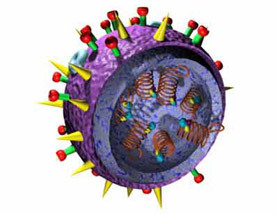
Model of the flu virus, made possible with information from NMR analysis.
NMR represents Nuclear Magnetic Resonance spectroscopy. It's a technology that led to the development of Magnetic Resonance Imaging. Many people have had MRI images where the tissue of a leg, a brain is imaged. NMR spectroscopy provides an image of a different sort. It's an image of a molecular structure. These could be molecules taken from biological systems, it could be molecules used in materials science. NMR is centered around placing samples in a very high magnetic field. We irradiate the sample with radio waves targeted for a specific atomic nucleus. Some spectroscopy is done on hydrogen, others on nitrogen or carbon. We're involved in a wide range of applications. We're interested in protein structures. In many cases these are drug targets and so by developing an image of what this drug target actually looks like it may be possible to develop a drug that will bind to that protein and inactivate the protein.


